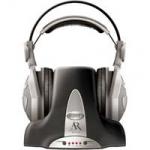Headphones: Technical
Terms You Should Know
There are a lot of technical terms in the world of home theater. This is a short list of some of the terms you will encounter when looking for your next set of headphones. Whether they are wireless headphones, noise canceling headphones, or even regular corded ones, the terms on this list will help you decipher the techno-babble.

Frequency Response - Frequency response is the range of sound in Hertz (Hz) that the drivers on headphones can produce. The range of hearing for the average human is between 20 and 20,000 Hz so you want headphones that can cover that range.
Open - Open refers to the design of the earpieces. These headphones are not sealed so sound from the outside world can be heard and they can hear sound bleeding from the earpieces. As a type of trade, the open earpiece design can give you a better sound quality than sealed headphones.
Closed/sealed - Headphones with closed earpiece design are also known as "sealed" headphones. These are used when sound isolation is needed. This isolation works both ways in terms of what is happening around you as well as preventing sound from bleeding out and disturbing others.
THD - THD stands for Total Harmonic Distortion. This is a representation of all of the distortion over a specific signal. THD for headphones, and everything else for that matter, is measured as a percentage. What you need to know is that a lower percentage is better because it means there will be less distortion in the signal. Not all headphone manufacturers put the THD in their specs but now you know what it means when you see it.
 S/N
Ratio - S/N Ratio is the
Signal-to-Noise Ratio. The S/N
Ratio is measured in decibels (dB) and gives you a value for the amount
of signal vs. the amount of noise that accompanies it. A
higher dB value is what you want to look for because it means that
there is more signal compared to the amount of noise.
S/N
Ratio - S/N Ratio is the
Signal-to-Noise Ratio. The S/N
Ratio is measured in decibels (dB) and gives you a value for the amount
of signal vs. the amount of noise that accompanies it. A
higher dB value is what you want to look for because it means that
there is more signal compared to the amount of noise.Impedance - This is the measure of a circuit's opposition to the flow of electrical current. The higher the impedance, the harder your home theater receiver will have to work in order to deliver its signal. What this means to you is that the lower the impedance the better when choosing your headphones. This applies to headphones of all types, whether they are wireless, surround sound, or noise canceling headphones. The impedance of your headphones will be measured in Ohms, denoted by the Greek letter omega.
RF Transmitter Frequency - Measured in megahertz (MHz), this is the frequency at which wireless headphones transmit and receive signals. 900 MHz is a common frequency used with wireless headphones and a quality pair can have a range of more than 300 feet.
RF Transmitter - RF transmitter stands for "Radio Frequency" Transmitter. The use of radio frequency allows for greater mobility than with headphones using an IR transmitter because they provide longer range and can transmit through many objects.
IR Transmitter - IR transmitters employ "Infrared" for signal transmission in wireless headphones. Since infrared is a form of light, wireless headphones using IR require a direct line of site to the transmitter for signal transfer.
Sensitivity - Sensitivity is a measure of how many decibels (db) are produced for each unit of power, in headphones this unit is usually in milliwatts (mW). The higher the sensitivity, the more efficient your headphones will be in producing sound. With this in mind, choose headphones with greater sensitivity.
Driver - The driver is what produces the sound in your headphones. It is created using an electrical device called a transducer which converts electrical signals into sound.
SPL - SPL stands for sound pressure level and is measured in decibels (dB). This is a measurement of the energy contained in a sound wave and is supposed to take into account how human ears function for the numeric values.